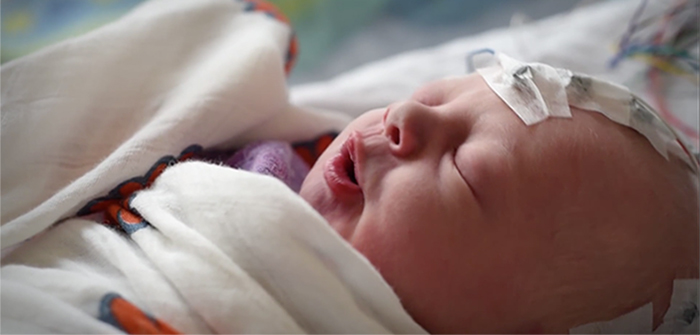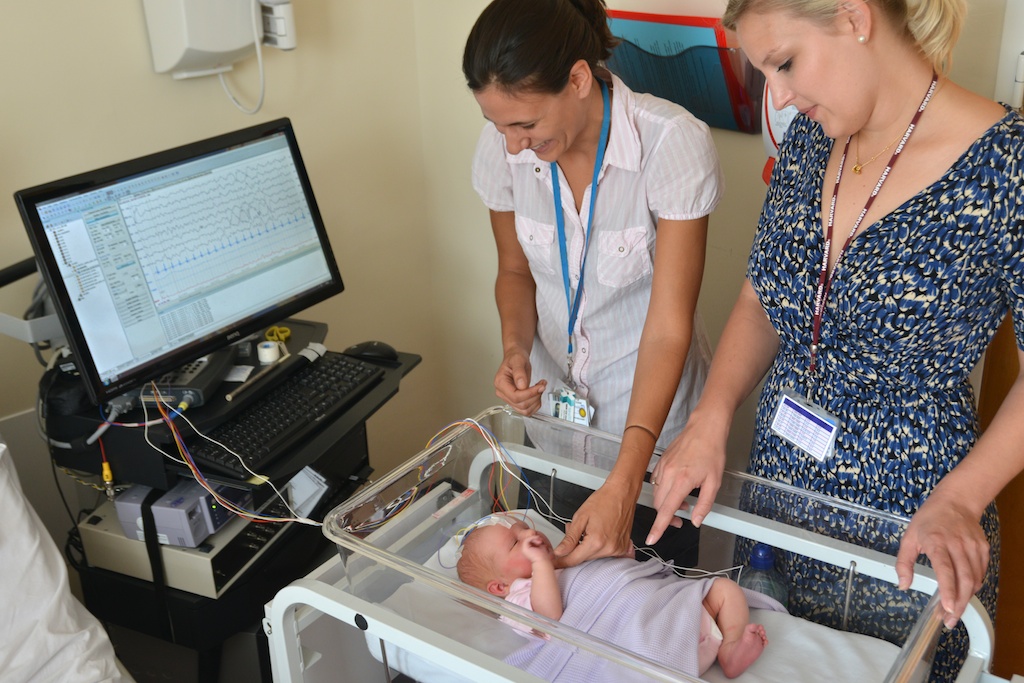Babies can’t tell us how much pain they’re in, which poses a problem for healthcare practitioners who are trying to manage their care. A new technique that uses non-invasive brain scans overcomes this frustrating limitation by providing what may be the first objective measure of infant pain.
Image: Oxford University
The new system, developed by researchers at Oxford University, uses an an electroencephalogram (EEG) to quantify the amount of pain-related brain activity experienced by an infant. While the system still needs to be refined for accuracy and isn’t quite ready for medical use, it could one day be used to assess the amount of pain a baby is enduring during a painful procedure, and the degree to which pain relievers may or may not be working. The details of this work can be found in the latest edition of Science Translational Medicine.
Because babies don’t speak, doctors and nurses have to rely on other measures to assess the degree of pain being experienced by their tiny patients. Crying and gesticulating are two obvious clues, but babies tend to do those things on the regular. Other indicators of pain include nostril flaring, bulging brows, eye squeezing, and an increased heart rate. These measures are highly subjective, and each baby expresses his or her own response to pain in specific ways, forcing healthcare practitioners to make an informed guess about the state of their patient.
[referenced url=”https://gizmodo.com.au/2016/02/why-are-so-many-newborns-still-being-denied-pain-relief/” thumb=”https://i.kinja-img.com/gawker-media/image/upload/t_ku-large/ulalkyie6nyrc7dg9env.png” title=”Why Are So Many Newborns Still Being Denied Pain Relief?” excerpt=”In 1985, a premature baby was born in Maryland who needed surgery to tie off a dangerous blood vessel near his heart. The newborn, Jeffrey, died weeks after the procedure. His family learned afterwards that none of the procedures had been performed with analgesics; the only drug administered was a muscle relaxant.”]
The inability to accurately detect and assess physical discomfort in an infant makes it difficult to prescribe pain relief, such as morphine, paracetamol, or local anaesthetics. In 2014, a review of neonatal pain management in intensive care units in Europe found that newborn babies experience an average of 11 painful procedures each day. And contrary to the longstanding and misguided belief that babies don’t feel pain, the latest scientific evidence suggests that newborns most definitely experience pain, and a levels equal to — if not greater than — adults. Pain experienced during infancy results in both short term and long term effects, such as diminished immune system, irritability, fear, and even developmental delays.
Scientists have been using various advanced techniques to detect pain in infants for years, including near-infrared spectroscopy, EEGs, and more recently fMRIs. But these techniques are not capable of telling scientists the degree of pain that’s being experienced. In an effort to overcome this limitation, Caroline Hartley and Rebecca Slater from the Department of Paediatrics at Oxford University developed a new system that finally does exactly that.

A baby with the non-invasive EEG cap on its head. (Image: University of Oxford)
“Many studies, from numerous research groups, have shown that a clear pattern of pain-related brain activity can be recorded in the infant brain which is graded with stimulus intensity, dependent on the age of the infant, and observed across a network of brain regions that are similar to those activated when an adult experiences pain,” explained Slater to Gizmodo. “Building on this work we have now created an EEG template of pain-related brain activity that can be projected onto a baby’s’ EEG activity after an acutely painful procedure which can quantify the degree of the noxious input that is reaching the infant brain.”
By “noxious” input, Slater is referring to a standard heel-lance procedure used for newborn blood screening. This involves a brief and mildly painful poke to a baby’s foot, which the researchers can detect and measure with an EEG. To develop their metric of pain, Hartley and Slater conducted a pilot study in which the brain activity of 18 infants was recorded while they were undergoing this procedure. This data was then validated in a subsequent study involving 72 babies in total, resulting in the EEG template.
Importantly, this pain signature was distinct from non-painful, or non-noxious control stimulation, such as bright lights and loud noises. It also correlated well with established behavioural measures of pain (e.g. grimacing, nostril flaring, etc.), and when infants were administered topical anesthetics, the pain signal recorded by the EEG was diminished. This means the system could be used to both identify and measure pain in an infant, and then determine whether or not a chosen mode of pain relief is working and to what degree.

Fiona Moultrie and Gabriela Schmidt Mellado, who contributed to the new study, monitor a baby for signs of discomfort. (Image: University of Oxford)
The signature demonstrated 64 per cent sensitivity with 65 per cent specificity for the pain associated with heel-lancing, which is good, but not great.
“The sensitivity of our template is the percentage of times that our template correctly identified pain-related brain activity when a noxious stimulus was applied,” explained Hartley to Gizmodo. “The specificity of our template is the percentage of times that our template correctly did not identify pain-related brain activity when a non-painful stimulus was applied.”
This means the technique will need to be improved before it can be used in a clinical setting. “The specificity and sensitivity was relatively low, so our measure of pain-related brain activity cannot currently be used in individual infants to determine whether they are in pain,” she said. “Instead, our measure is useful in research studies or clinical trials where we can investigate how groups of infants respond to different treatments or interventions.”
Hartley and Slater are now using their EEG template in the Poppi Trial (Procedural Pain in Premature Infants) to test whether morphine can provide effective pain relief for prematurely-born babies during invasive medical procedures. Research done a decade ago showed that infants born at less than 29 weeks may experience 300 or more painful procedures over a 3-month stay in a neonatal intensive care unit, including eye exams, blood sampling with a standard needle, an AquaMEPHYTON injection (a liquid vitamin solution), venipuncture (making an intravenous puncture), heel lance, and a series of nursing procedures.
“We will test whether babies who are given morphine experience less pain, and whether reducing pain during a painful eye exam improves the stability of the babies heart beat and breathing after the procedure,” said Hartley.
In terms of an eventual clinical application, the good news is that improvements may be possible. According to Hartley, the brain develops rapidly during early life, and scientists know from previous research that pain-related brain activity increases with gestational age (pain appears differently in the brains of very preterm infants). She says the measure could be improved by taking age-related changes into account.
“Traditionally, pain assessments in newborns have been performed by observers — such as nurses and doctors — who, based on their clinical experience, subjectively try to interpret the changes in vital signs (highly non-specific) and behaviours (somewhat more specific) following acute pain in newborns,” said Kanwaljeet J. S. Anand, a professor of Pediatrics and Anesthesiology at the Stanford University School of Medicine who was not involved in the study, in an interview with Gizmodo. “This is the first objective measure that records and interprets changes in the brain’s electrical activity following acute pain and it does not depend on a clinician’s subjective interpretation. That is a significant advance.”
Anand said the experiments described in the new paper were well designed and “beautifully presented,” but he did point out some limitations.
“Important differences in postnatal age, weight, sex, severity of illness, and other characteristics…may have affected the results,” he said. “For example, EEG patterns mature rapidly due to the baby’s postnatal experience and will occur within one week after birth. These [changes] were not accounted for in their data analyses.”
Anand, a pioneer in the study of infant pain, said the vast majority of painful stimuli occurs in preterm infants who are born at less than 34 weeks of gestation. “However, their results and the EEG template generated can only be applied to infants born at or after 34 weeks of pregnancy,” he said. “This approach to measuring pain cannot be applied to newborn populations that suffer the greatest amounts of pain.”
He was also keen to point out that the focus of the new study was limited to the brief, acute pain caused by the heel-lance procedure. Unfortunately, many babies are exposed to far worse than that, yet there’s still a reluctance to recognise and treat their pain. A recent study co-authored by Anand shows that a scant 10 per cent of newborns admitted to a NICU receive daily assessments of prolonged and continuous pain. He says it’s time for a paradigm shift in the way doctors manage neonatal pain.
“A huge burden of pain exists in non-acute pain and no studies, not even this one, are addressing that — the hidden part of the iceberg,” said Anand.
